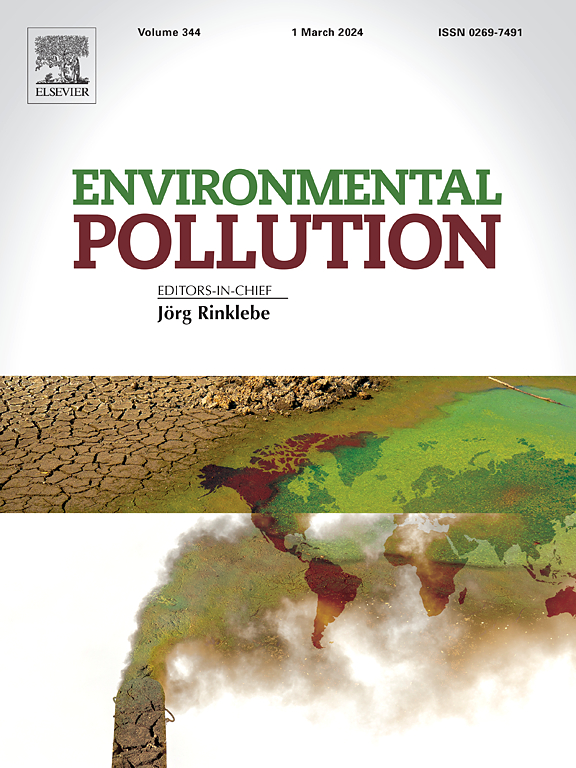产前暴露于细颗粒物成分和脑瘫风险:加拿大安大略省一项基于人群的回顾性队列研究
IF 7.6
2区 环境科学与生态学
Q1 ENVIRONMENTAL SCIENCES
引用次数: 0
摘要
现有文献表明,产前暴露于细颗粒物空气污染(PM2.5)与脑瘫(CP)之间存在关联。然而,PM2.5各组分(SO42-、NH4+、NO3-、SS、BC、粉尘、OM)对CP风险的影响尚不清楚。目的研究加拿大安大略省足月新生儿产前暴露于PM2.5成分与CP风险之间的关系。方法回顾性队列研究纳入2002年4月至2020年12月的足月新生儿(胎龄≥37完整周)。利用基于卫星的估算和地面监测数据,将PM2.5总质量和成分测量值分配给分娩时的孕产妇居住地。使用卫生管理数据库汇编队列数据。采用单污染物分布滞后cox比例风险模型,对PM2.5残差进行和不进行额外调整,研究妊娠期暴露于PM2.5总质量及其成分之间的关系。结果共鉴定出2193427对母婴,其中3907对在随访期间被诊断为CP。在残差校正模型(HR: 1.052, 95% CI: 1.009-1.097,每IQR=0.94 ug/m3)和未校正模型(HR: 1.050, 95% CI: 1.007- 1.095,每IQR=0.94 ug/m3)中,妊娠早期暴露于SO42均发现CP风险增加。SO42-和CP风险的敏感窗口(妊娠4 - 9周)之间的浓度-反应关系显示出超线性模式。结论产前暴露于SO42-可能与妊娠早期CP风险增加有关。产前PM2.5总质量和成分暴露与CP风险之间的关系有待进一步研究。本文章由计算机程序翻译,如有差异,请以英文原文为准。


Prenatal exposure to fine particulate matter composition and risk of cerebral palsy: A population-based retrospective cohort study in Ontario, Canada
Background
Existing literature suggests an association between prenatal exposure to fine particulate air pollution (PM2.5) and cerebral palsy (CP). However, the impact of individual PM2.5 components (SO42−, NH4+, NO3−, SS, BC, dust, OM) on CP risk remains unknown.
Objective
To examine the associations between prenatal exposure to PM2.5 components, and risk of CP among term births in Ontario, Canada.
Methods
This was a retrospective cohort study that examined term births (gestational age ≥37 completed weeks) from April 2002 to December 2020. PM2.5 total mass and composition measures were assigned to maternal residence at birth using satellite-based estimates and ground-level monitoring data. Cohort data were compiled using health administrative databases. Single-pollutant distributed lag cox proportional hazard models, with and without additional adjustment for PM2.5 residuals, were used to investigate the associations between gestational exposures to PM2.5 total mass and its components.
Results
2,193,427 mother-infant pairs were identified, of which 3907 were diagnosed with CP during the follow-up period. Increased risk of CP was found for SO42− exposure during early pregnancy in both residual-adjusted (HR: 1.052, 95 % CI: 1.009–1.097, per IQR = 0.94 μg/m3), and non-adjusted models (HR: 1.050, 95 % CI: 1.007–1.095, per IQR = 0.94 μg/m3). The concentration-response relationship between the sensitive window found for SO42− and CP risk (weeks 4–9 of gestation) showcased a supralinear pattern.
Conclusions
Prenatal exposure to SO42− may be associated with increased CP risk during the early pregnancy period. Associations between prenatal PM2.5 total mass and composition exposure and CP risk should be further investigated.
求助全文
通过发布文献求助,成功后即可免费获取论文全文。
去求助
来源期刊

Environmental Pollution
环境科学-环境科学
CiteScore
16.00
自引率
6.70%
发文量
2082
审稿时长
2.9 months
期刊介绍:
Environmental Pollution is an international peer-reviewed journal that publishes high-quality research papers and review articles covering all aspects of environmental pollution and its impacts on ecosystems and human health.
Subject areas include, but are not limited to:
• Sources and occurrences of pollutants that are clearly defined and measured in environmental compartments, food and food-related items, and human bodies;
• Interlinks between contaminant exposure and biological, ecological, and human health effects, including those of climate change;
• Contaminants of emerging concerns (including but not limited to antibiotic resistant microorganisms or genes, microplastics/nanoplastics, electronic wastes, light, and noise) and/or their biological, ecological, or human health effects;
• Laboratory and field studies on the remediation/mitigation of environmental pollution via new techniques and with clear links to biological, ecological, or human health effects;
• Modeling of pollution processes, patterns, or trends that is of clear environmental and/or human health interest;
• New techniques that measure and examine environmental occurrences, transport, behavior, and effects of pollutants within the environment or the laboratory, provided that they can be clearly used to address problems within regional or global environmental compartments.
 求助内容:
求助内容: 应助结果提醒方式:
应助结果提醒方式:


